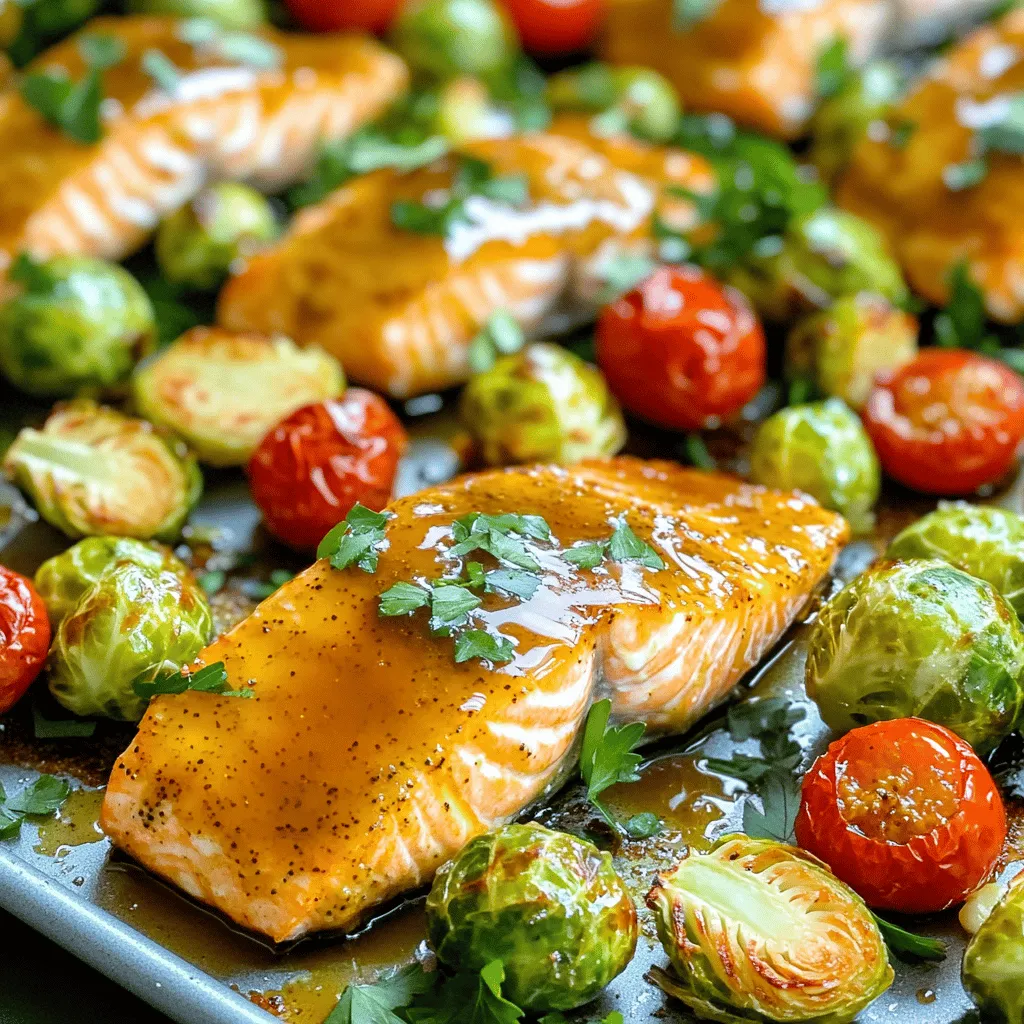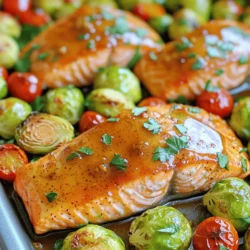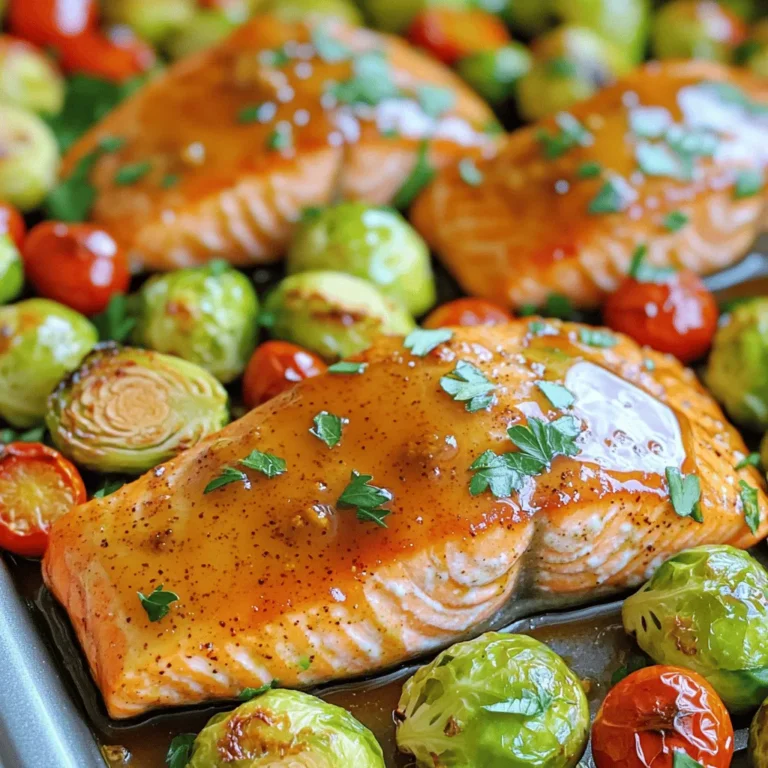Looking for a quick and tasty dinner idea? Try my Sheet Pan Maple Dijon Salmon! This dish is simple to make and packed with flavor. With just one pan, you get a wholesome meal of salmon and veggies that even picky eaters will love. Follow me as I share easy steps, helpful tips, and delicious variations. You’re just a few clicks away from a meal you’ll enjoy!
Ingredients
Detailed Ingredient List
To make Sheet Pan Maple Dijon Salmon, gather these key ingredients:
- 4 salmon fillets (about 6 oz each)
- 1/4 cup pure maple syrup
- 2 tablespoons Dijon mustard
- 2 tablespoons olive oil
- 1 tablespoon apple cider vinegar
- 2 cloves garlic, minced
- Salt and pepper to taste
- 1 pound Brussels sprouts, trimmed and halved
- 1 cup cherry tomatoes, halved
- 1 teaspoon smoked paprika
- Fresh parsley, chopped for garnish
Notes on Ingredient Quality
Choosing the best ingredients makes a big difference. I always pick fresh salmon fillets. Look for firm, bright-colored fillets. The skin should also be shiny and not slimy. For the maple syrup, go for pure syrup, not the fake stuff. It has better flavor and quality. Fresh Brussels sprouts and ripe cherry tomatoes enhance the dish’s taste. Always check for firmness and bright colors when buying these vegetables.
Substitutions for Key Ingredients
You can easily swap some ingredients if needed. If you don’t have Dijon mustard, use whole grain mustard for a similar taste. Maple syrup can be replaced with honey, but the flavor will change a bit. Olive oil can be swapped with melted butter for a richer taste. If you can’t find Brussels sprouts, try green beans or asparagus instead. For cherry tomatoes, you can use diced bell peppers to add color and crunch.
Step-by-Step Instructions
Prepping Your Ingredients
To start, gather all your ingredients. This keeps your kitchen tidy and ready. You need four salmon fillets, Brussels sprouts, and cherry tomatoes. Also, get maple syrup, Dijon mustard, olive oil, apple cider vinegar, garlic, salt, and pepper. Chop the garlic finely. Trim and halve the Brussels sprouts. Halve the cherry tomatoes.
Marinade Preparation
In a small bowl, mix the marinade. Whisk together 1/4 cup of maple syrup, 2 tablespoons of Dijon mustard, and 2 tablespoons of olive oil. Add 1 tablespoon of apple cider vinegar and the minced garlic. Season with salt and pepper. Mix until it is smooth. This marinade brings a sweet and tangy flavor to the salmon.
Salmon and Vegetable Assembly
Line a sheet pan with parchment paper for easy cleanup. Place the salmon fillets on the pan and brush them with the marinade. Save some marinade for later. Then, add the Brussels sprouts and cherry tomatoes to the same pan. Drizzle with olive oil and sprinkle with smoked paprika, salt, and pepper. Toss the vegetables gently to coat them with the oil and spices.
Baking Instructions
Now it’s time to bake! Preheat your oven to 400°F (200°C). Roast the salmon and veggies in the oven for 15-20 minutes. The salmon should flake easily with a fork when done. Halfway through, brush the salmon with the reserved marinade for more flavor. Once everything is cooked, sprinkle chopped parsley on top before serving. Enjoy your meal!
Tips & Tricks
How to Perfectly Cook Salmon
To cook salmon just right, start with fresh fillets. You want them to be bright in color. A good rule is to bake at 400°F for 15 to 20 minutes. The salmon should flake easily with a fork when done. If you want to make sure it’s cooked, use a meat thermometer. The internal temp should reach 145°F. Always keep an eye on it to avoid drying out.
Enhancing Flavors with Marinades
Marinades bring out the best in salmon. The mix of maple syrup and Dijon mustard is key here. This sweet and tangy blend gives salmon a tasty boost. Let the salmon soak in the marinade for at least 15 minutes. This allows the flavors to soak in. You can brush more marinade on halfway through baking for extra flavor. Don’t be shy about seasoning your veggies too!
Best Practices for Sheet Pan Meals
Using a sheet pan makes cooking easy and fun. Spread out your veggies evenly for even cooking. Make sure they are not crowded; this helps them roast well. Always line your pan with parchment paper for easy cleanup. For best results, cut your veggies into similar sizes. This helps them cook at the same rate. Enjoy the simplicity and let your oven do the work!

Variations
Alternative Vegetables to Use
You can change the veggies in this dish. Try using asparagus or green beans. Broccoli or zucchini would also work well. These vegetables roast nicely and soak up the flavors. You can mix and match to suit your tastes. Just remember to cut them into similar sizes for even cooking.
Adjusting Sweetness and Tartness
If you want a sweeter dish, add more maple syrup. You can start with an extra tablespoon. For more tartness, add a bit more apple cider vinegar. This will balance the flavors well. Taste the marinade before you use it. Adjust it to your liking for the perfect mix.
Adding Spices for Extra Flavor
Want to spice things up? Add some red pepper flakes for heat. You can also try ground cumin for a warm flavor. A pinch of dried thyme or rosemary will add a nice herbal touch. Mix in any spices you love. This will make your meal more unique and tasty.
Storage Info
How to Store Leftovers
After your meal, let the salmon cool to room temp. Place leftovers in an airtight container. Store them in the fridge for up to three days. This keeps the salmon and veggies fresh. If you plan to eat them later, store them separately. This helps keep the salmon from getting soggy.
Reheating Instructions
To reheat, use the oven for best results. Preheat your oven to 350°F (175°C). Place the salmon and veggies on a baking sheet. Heat for about 10-15 minutes, until warm. You can also use the microwave. Heat in short bursts of 30 seconds. Check often to avoid overcooking.
Freezing Options
You can freeze this dish too. Wrap the salmon and veggies tightly in plastic wrap. Then place them in a freezer-safe bag. This helps prevent freezer burn. They will keep for about three months. When you’re ready to eat, thaw them overnight in the fridge. Reheat as mentioned above for the best taste.
FAQs
Can I use frozen salmon for this recipe?
Yes, you can use frozen salmon. Just make sure to thaw it first. To thaw, place the salmon in the fridge overnight or submerge it in cold water for about an hour. Once thawed, follow the same steps as you would with fresh salmon. Just remember to check the cooking time. Thicker fillets may need a few extra minutes in the oven.
What should I serve with Sheet Pan Maple Dijon Salmon?
Sheet Pan Maple Dijon Salmon pairs well with many sides. Here are some great options:
- Quinoa or rice for a filling base.
- A fresh green salad with light dressing.
- Garlic bread for a tasty addition.
- Roasted or steamed vegetables for extra color.
These sides bring balance and make your meal more complete.
How do I know when the salmon is done cooking?
To check if your salmon is done, look for the following:
- The salmon should be opaque and flake easily with a fork.
- The internal temperature should reach 145°F (63°C).
- If you see white albumin on the surface, it’s a sign of doneness.
Using these tips, you’ll serve perfect salmon every time.
This guide covers all you need for Sheet Pan Maple Dijon Salmon. We explored the best ingredients, prepping steps, and cooking tips. I shared ways to enhance flavor and various ideas for serving. Remember, you can store leftovers and freeze extra meals too.
Enjoying healthy meals can be easy and tasty. With these tips, you’ll create a dish everyone loves. Try it out and make it your own!


